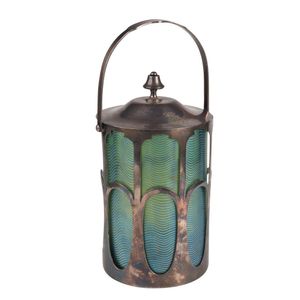Art Nouveau Biscuit Barrel with Favrile Glass and EPNS Mount
Biscuit barrel early 20th century, Austrian favrile glass, Art Nouveau style with EPNS metal lidded mount, Johannes Loetz Witwe-Bohemia, Glaser a La Tiffany, 21 x 13 cm
You must be a subscriber, and be logged in to view price and dealer details.
Subscribe Now to view actual auction price for this item
When you subscribe, you have the option of setting the currency in which to display prices to $Au, $US, $NZ or Stg.
This item has been sold, and the description, image and price are for reference purposes only.
- Art Nouveau Period - The Art Nouveau period was a cultural movement that emerged in the late 19th century, and was characterized by its emphasis on natural forms, flowing lines, and a decorative, ornamental style. Art Nouveau was a reaction against the ornate and heavily stylized designs of the previous era, and sought to create a new, more organic aesthetic.
Art Nouveau was characterized by its use of sinuous, curving lines, as well as a focus on natural elements such as flowers, vines, and other organic shapes. Art Nouveau designers sought to create a total work of art, in which every element of a building or object was designed to be harmonious with the overall design.
Some of the most iconic examples of Art Nouveau design include the Paris Metro entrances designed by Hector Guimard, the works of the artist Alphonse Mucha, and the architecture of Victor Horta in Brussels.
The Art Nouveau period was at its peak between 1890 and 1910, but began to decline in popularity by the start of World War I. However, Art Nouveau remains an important influence on design and art to this day, and continues to be celebrated for its emphasis on natural forms and decorative style. - Favrile - Favrile glass is a type of iridescent art glass, similar to some of the Roman glass that has been excavated after being buried for centuries. It was developed by Louis Comfort Tiffany in 1892, patented in 1894 and the first itmes were produced in 1896. It differs from most iridescent glasses because the colour is ingrained in the glass itself, instead of being sprayed onto the surface while the glass was molten, as with Carnival glass.
The most common items manufactured by Tiffany in favrile glass were vases.
The glass was imitated by Loetz and other Bohemian manufacturers.
This item has been included into following indexes:
Visually similar items

9ct gold and opal pendant converted from brooch, weight: approx 3.38 grams, size: approx 3 x 2.5 cm
Sold by
in
for
You can display prices in $Au, $US, $NZ or Stg.

Russian silver engraved cigarette case
Sold by
in
for
You can display prices in $Au, $US, $NZ or Stg.

A Chinese yellow chicken bone jade brush washer in a basket form. 20th century. 4.5 cm high
Sold by
in
for
You can display prices in $Au, $US, $NZ or Stg.

Real tortoiseshell oblong box with lid, approx 3.5 cm high, 9 cm long, 6 cm deep
Sold by
in
for
You can display prices in $Au, $US, $NZ or Stg.
